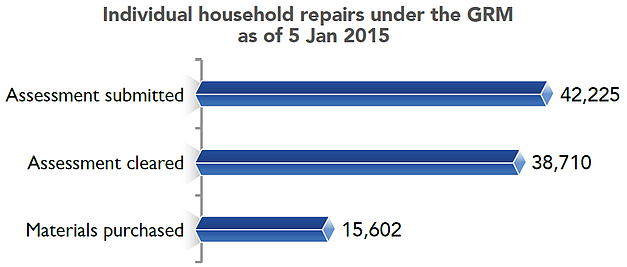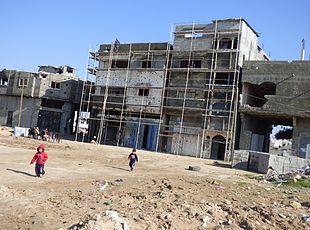Reconstruction of homes delayed as pledged funds are not disbursed
Significant increase in the number of individual cases assessed and cleared
Nearly 40,000 individuals (out of approximately 100,000) whose homes were damaged or destroyed during the summer hostilities have been cleared to purchase restricted construction materials under the temporary Gaza Reconstruction Mechanism (GRM), as of 5 January. This represents a fivefold increase compared with the previous month.
The total number of people actually purchasing materials also increased during December, but comprises less than 40 per cent of the individuals approved (approx. 15,500). This is mainly due to a lack of economic resources in eligible households because of limited disbursement of funds pledged by member states during the October 2014 Cairo Conference for the reconstruction of Gaza.
Despite the funding constraints, the increase in the number of approved cases led to the volume of building materials imported during December (2,259 truckloads) almost tripling compared with the previous three months (733 on average). According to estimates by the Shelter Cluster, the inflow of construction materials into Gaza should be 735 truckloads per day, seven days a week, to cover housing reconstruction and repair needs within three years.

What is the temporary Gaza Reconstruction Mechanism?
 The Gaza Reconstruction Mechanism (GRM) enables the Government of Palestine (GoP) to lead reconstruction efforts for housing and infrastructure damaged or destroyed during the hostilities of July/August 2014, while addressing Israeli security concerns. The mechanism permits the import into Gaza of basic construction materials, severely restricted by the Israeli authorities since the imposition of the blockade in 2007 under security concerns about their use for military purposes. Construction under the GRM is carried out by the private sector in Gaza, including the import and selling of materials by vendors approved by the GoP. Vendors are vetted and must meet strict stock management and asset protection requirements. Individual home owners require a basic assessment approved by the Palestinian Ministry of Civil Affairs to be eligible to purchase the restricted materials for repairs or reconstruction. A list of the names of families cleared to access construction materials has been made available online. Infrastructure projects are identified based on the GoP National Early Recovery and Reconstruction Plan for Gaza and are included in the database after approval by the Israeli authorities.
The Gaza Reconstruction Mechanism (GRM) enables the Government of Palestine (GoP) to lead reconstruction efforts for housing and infrastructure damaged or destroyed during the hostilities of July/August 2014, while addressing Israeli security concerns. The mechanism permits the import into Gaza of basic construction materials, severely restricted by the Israeli authorities since the imposition of the blockade in 2007 under security concerns about their use for military purposes. Construction under the GRM is carried out by the private sector in Gaza, including the import and selling of materials by vendors approved by the GoP. Vendors are vetted and must meet strict stock management and asset protection requirements. Individual home owners require a basic assessment approved by the Palestinian Ministry of Civil Affairs to be eligible to purchase the restricted materials for repairs or reconstruction. A list of the names of families cleared to access construction materials has been made available online. Infrastructure projects are identified based on the GoP National Early Recovery and Reconstruction Plan for Gaza and are included in the database after approval by the Israeli authorities.
UNRWA continues support for shelter repairs amid severe financial constraints
* This section was contributed by UNRWA
As of mid-January 2015, UNRWA had disbursed over USD $77.6 million to families eligible for shelter packages. The bulk of these funds ($67 million) was distributed to over 59,000 refugee families for home repairs, and the rest as transitional shelter cash assistance (TSCA), covering up to the end of 2014 and reintegration payments to refugee families with uninhabitable or destroyed homes.
Over 96,000 homes of Palestinian refugees were damaged or destroyed during the conflict according to a technical assessment completed by UNRWA on 15 December. The Agency extended a one-week window from 21 to 25 December for any refugee families requiring assessment. It is anticipated that the number of homes affected will rise to over 100,000 once the appeal process concludes. UNRWA estimates a total funding requirement of $720 million for TSCA, reintegration payments, and repair and reconstruction of refugee homes. To date, only five per cent ($35 million) has been pledged, leaving a major funding gap.
As an innovative measure to provide shelter to more families, UNRWA has commenced a pilot building project that involves completing partially finished dwellings. The owners of unfinished buildings select families to rent their property and UNRWA contributes to the completion/renovation of the homes. The initiative serves to increase the current stock of housing units in Gaza and reduces the number of IDP families remaining inside Collective Centres and tented camps. It is also designed to reduce the financial pressure on families hosting IDPs. The initial pilot project involving ten buildings and ten families is close to completion. Based on its initial success, it is hoped that the project can be expanded, subject to additional funding.
UN projects pending for long periods of time approved by the Israeli authorities
In December, the Israeli authorities announced the approval of $37.8 million worth of UN rehabilitation and infrastructure projects in Gaza, involving the construction of schools, housing units, roads and medical centres. These projects were pending for an average of two years.
Since mid-2010, Israel has exceptionally allowed international organizations to import building materials into Gaza, on condition that the projects are approved in advance by the Israeli Ministry of Defense. The approval process has proven problematic and has resulted in significant delays that impede the ability of agencies to respond to urgent needs.
The recent approvals will probably be the last within this mechanism, which has now transitioned to the GRM. Since it started in 2010, the former mechanism resulted in the approval of UN projects worth $534.2 million and the rejection of $54.4 million of other projects.
Under the GRM, the Israeli authorities will consider comprehensive programmes of work rather than individual projects, allowing for quicker and more efficient implementation. A High Level Steering Team, consisting of representatives from the GoP, Israel and the UN, has been established to coordinate the implementation process. Ten plans of work have been already submitted by the GoP and a further four are in progress.









